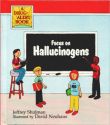an uneven book that makes a heroic effort to describe the potent psychedelic entheogen from many points of view. It describes the use of this plant by the Bwiti tradition of West Central Africa from its earliest recorded history in the nineteenth century through the present day. [ read more ]
...how did America’s relationship with psychoactive substances become so troubled? In The Cult of Pharmacology Richard DeGrandpre argues that dominant voices in US culture and science distort our understanding of psychoactive substances through a form of essentialism he calls “pharmacologicalism”, in which drug effects are explained entirely by the physical and chemical properties of the drugs themselves. [ read more ]
The Cacahuatl Eater leaves no stone unturned in telling the story of mighty chocolate. Ott sketches the cultivation of the plant Theobroma cacao from seed to sprout to fruit, then follows the harvested bean all the way through the production process to the dessert plate. He considers the cultural history of cacao, focusing on its use by the Aztecs, who not only drank a frothy, bitter beverage brewed from its beans, but used them as currency as well. [ read more ]
Focus on Hallucinogens is much better than it could be. While it does not acknowledge that anyone in the modern world could take psychedelics and have a pleasant or useful experience, it is well-researched and it contains some good information. Shulman offers a decent middle school primer to hallucinogens and gives a serviceable overview of the history of their use in traditional cultures. [ read more ]
Among books on psychoactive mushrooms, Shroom is unprecedented in the degree to which the author demands that arguments be supported by evidence. No brief review can do justice to the rich detail and close analysis that Letcher offers. This is an essential book on the subject, and an important step forward in the evolution of how we talk about the history of entheogens. [ read more ]
... [T]he shadow side of this book’s legacy is that it has helped create a state of confusion among its readership. Strassman’s outstanding work is marred by unsubstantiated speculation regarding possible connections between meditation, death and dying, the pineal gland, endogenous DMT, and quantum mechanics. [ read more ]
This book is particularly memorable for its many wonderful accounts of animal intoxication. Despite the title, most of the cases that Samorini recounts do not involve psychedelics, though he does describe some greedy goats refusing to share Psilocybe mushrooms. Like Jonathan Ott in Pharmacophilia, Samorini contends that intoxication is natural. It is an instinctual drive commonly found in many animal species, and not the debased artifact of corrupt human society that it is commonly believed to be. [ read more ]
Hunter S. Thompson’s magnum opus records a semi-fictionalized drug-fueled torpedo ride through the incandescent heart of Las Vegas in search of the American Dream. Ablaze with mescaline, LSD, cannabis, ether – hell, you name it – Thompson’s literary alter-ego Raoul Duke wanders under the bright lights of the strip with his attorney Dr. Gonzo. [ read more ]
Nearly 60 years after it was published, Carbon Dioxide Therapy remains the definitive statement on carbogen as a psychiatric tool for treatment of neurosis. The book’s author administered a blend called “Meduna’s Mixture”, consisting of 30% carbon dioxide and 70% oxygen, to hundreds of patients, and the results of his research are copiously document in this engaging monograph. Exposure to increased levels of carbon dioxide can be dangerous or even be fatal, but Meduna encountered no serious problems in administering his 70/30 blend in sessions of up to 50 breaths in length. [ read more ]
Some of the material in this book is irreducibly technical and will be intelligible only to people with backgrounds in chemistry. However, the novice reader can easily skim the brief technical digressions and understand the majority of the book.
[ read more ]











